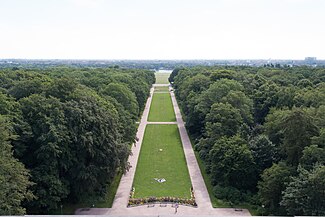Hamburg Stadtpark
| Hamburg Stadtpark | |
|---|---|

View of the Stadtpark from atop of Hamburg Planetarium
|
|
| Type | Public park |
| Location | Saarlandstraße 1 22303 Hamburg, Germany |
| Coordinates | 53°35′55″N 10°01′27″E / 53.598745°N 10.02403°ECoordinates: 53°35′55″N 10°01′27″E / 53.598745°N 10.02403°E |
| Area | 148 ha (1.48 km2) |
| Opened | 1914 |
| Managed by | BSU |
| Open | All year |
| Public transit access |
|
| Website | www |
Hamburg Stadtpark is a 148 hectares (366 acres) large urban park in the Hamburg district of Winterhude, in the borough of Hamburg-Nord. Alongside Altona Volkspark, it is the largest park in the Free and Hanseatic City of Hamburg, Germany. The Stadtpark is regarded as the "green heart" of the city, despite being located some 3km from the inner city. The largest parks in the city center are Planten un Blomen and the Alsterpark.
Opened in 1914, Hamburg Stadtpark is an important example of German landscape design and the transformation from an urban garden to an urban park.
Like many cities during the Age of Industrialization, Hamburg grew substantially in the later decades of the 19th century and many former open spaces had been built over. In order to counterbalance this development, in 1901 the Senate of Hamburg and Hamburg Parliament agreed to purchase the so-called Sierich Grove (Sierichsches Gehölz), and to develop an urban park. In 1908 a public design competition was hosted, however no consensus could be reached. In January 1909, head engineer Fritz Sperber presented two designs - based on the results of the competition - on behalf of the senate, one landcaped and painterly, the other geometric. In June 1909, Fritz Schumacher was made director of the city's Department of Planning and Building Inspection, and in January 1910 he and Fritz Sperber presented a design to the Parliament which was subsequently approved. The park was opened four years later, though it would be another 14 years before it was finally completed. After 1918, the gardening and landscaping work was principally carried out by Otto Linne, the first horticultural director of Hamburg.
...
Wikipedia
